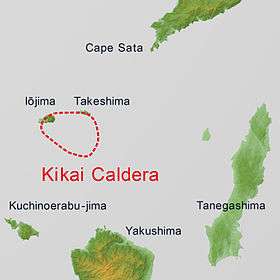Kikai Caldera
Not to be confused with the island Kikaijima nor the town on it Kikai, Kagoshima
| Kikai Caldera | |
|---|---|
| 鬼界カルデラ | |
 | |
| Highest point | |
| Peak | Mount Iō (Iōjima) (Iōjima) |
| Elevation | 704 m (2,310 ft) |
| Dimensions | |
| Length | 17 km (11 mi) NS |
| Width | 20 km (12 mi) EW |
| Geography | |
| Country | Japan |
| State | Kagoshima Prefecture |
| Region | Ōsumi Islands |
| District | Kagoshima District |
| Geology | |
| Age of rock | 6,300 to 95,000 years ago |
Kikai Caldera (鬼界カルデラ Kikai karudera) is a massive, mostly submerged caldera up to 19 kilometres (12 mi) in diameter in the Ōsumi Islands of Kagoshima Prefecture, Japan. It is the remains of the ancient eruption of a gigantic volcano.
Kikai Caldera was the source of the Akahoya eruption, one of the largest eruptions during the Holocene (10,000 years ago to present). About 6,300 years ago, pyroclastic flows from that eruption reached the coast of southern Kyūshū up to 100 km (62 mi) away, and ash fell as far as Hokkaidō. The eruption produced about 150 km³ of tephra,[1] giving it a Volcanic Explosivity Index of 7[2] and making it one of the most explosive in the last 10,000 years, ranking alongside Santorini, Changbaishan, Crater Lake, Kurile Lake and Tambora.[3]
Kikai is still an active volcano. Minor eruptions occur frequently on Mount Iō (硫黄岳 Iō-dake), one of the post-caldera subaerial volcanic peaks on Iōjima (硫黄島 Iō-jima). Iōjima is one of three volcanic islands, two of which lie on the caldera rim. The most recent eruptions occurred in 2013.
Further reading
- Machida, Hiroshi; Sugiyama, Shinji (2002). "The impact of the Kikai-Akahoya explosive eruptions on human societies". In Grattan, John; Torrence Robin (Ed.). Natural Disasters and Cultural Change. London: Routledge. pp. 313–346. ISBN 0-415-21696-6.
See also
References
- "Kikai". Global Volcanism Program. Smithsonian Institution.
- "KIKAI Caldera". Quaternary Volcanoes in Japan. Geological Survey of Japan, AIST. 2006. Retrieved 2009-01-08.
- VolcanoWorld - Kikai, Kyūshū, Japan
- 鬼界カルデラ Kikai Caldera 独立行政法人 産業技術総合研究所 地 質 調 査 総 合 セ ン タ ー
- Kikai Caldera - Volcano Photos
- ↑ Kikai - Eruptive history, Global Volcanism Program. Smithsonian Institution.
- ↑ Johnston, Eric, "Latest volcano show: Shinmoe", Japan Times, 1 March 2011, p. 3.
- ↑ "Large Volcano Explocivity Index". Countries of the World. Retrieved 2014-04-24.
External links
- Satsuma-iojima - Geological Survey of Japan
- Kikai - Geological Survey of Japan
- Geology and eruptive history of Kikai Caldera - Earthquake Research Institute,The University of Tokyo
- Kikai: Global Volcanism Program - Smithsonian Institution